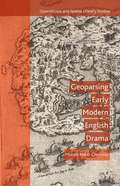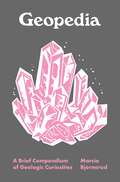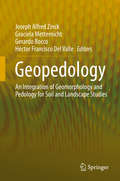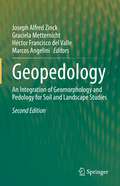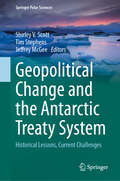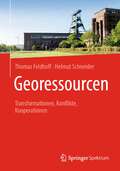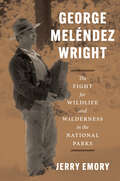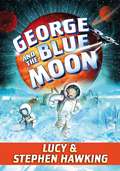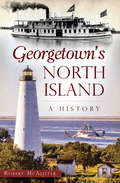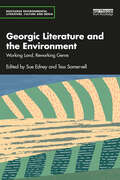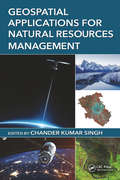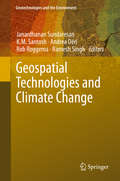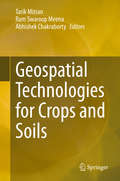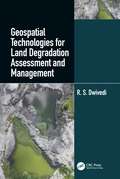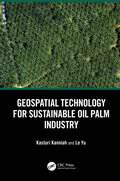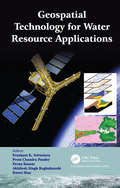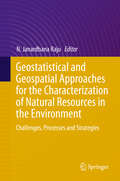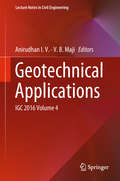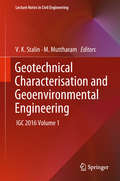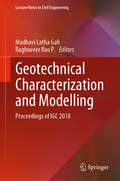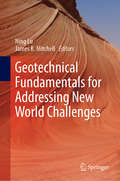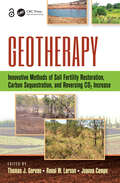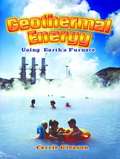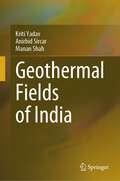- Table View
- List View
Geoparsing Early Modern English Drama
by Monica Matei-ChesnoiuGeo-spatial identity and early Modern European drama come together in this study of how cultural or political attachments are actively mediated through space. Matei-Chesnoiu traces the modulated representations of rivers, seas, mountains, and islands in sixteenth-century plays by Shakespeare, Jasper Fisher, Thomas May, and others.
Geopedia: A Brief Compendium of Geologic Curiosities (Pedia Books #6)
by Marcia BjornerudA garden of geologic delights for all EarthlingsGeopedia is a trove of geologic wonders and the evocative terms that humans have devised to describe them. Featuring dozens of entries—from Acasta gneiss to Zircon—this illustrated compendium is brimming with lapidary and lexical insights that will delight rockhounds and word lovers alike.Geoscientists are magpies for words, and with good reason. The sheer profusion of minerals, landforms, and geologic events produced by our creative planet demands an immense vocabulary to match. Marcia Bjornerud shows how this lexicon reflects not only the diversity of rocks and geologic processes but also the long history of human interactions with them.With wit and warmth, she invites all readers to celebrate the geologic glossary—a gallimaufry of allusions to mythology, imports from diverse languages, embarrassing anachronisms, and recent neologisms. This captivating book includes cross-references at the end of each entry, inviting you to leave the alphabetic trail and meander through it like a river. Its pocket-friendly size makes it the perfect travel companion no matter where your own geologic forays may lead you.With whimsical illustrations by Haley Hagerman, Geopedia is a mix of engaging and entertaining facts about how the earth works, how it has coevolved with life over billions of years, and how our understanding of the planet has deepened over time.Features a real cloth cover with an elaborate foil-stamped design
Geopedology
by Joseph Alfred Zinck Graciela Metternicht Gerardo Bocco Héctor Francisco Del ValleThis book offers a proven approach for reliable mapping of soil-landscape relationships to derive information for policy, planning and management at scales ranging from local to regional. It presents the theoretical and conceptual framework of the geopedologic approach and a bulk of applied research showing its application and benefits for knowledge generation relevant to geohazard studies, land use conflict analysis, land use planning, land degradation assessment, and land suitability analysis. Soil is a vital resource for society at large and an important determinant of the economic status of nations. The intensification of natural disasters and the increased land use competition for food and energy have raised awareness of the relevant role the pedosphere plays in natural and anthropogenic environments. Recent papers and global initiatives show a renewed interest in soil research and its applications for improved planning and management of this fragile and finite resource.
Geopedology: An Integration Of Geomorphology And Pedology For Soil And Landscape Studies
by Joseph Alfred Zinck Graciela Metternicht Héctor Francisco del Valle Marcos Angelini<p>This updated and revised second edition brings geopedology issues into the current context. This new edition extends the work on popular topics such as digital soil mapping, GIS and landscape mapping, and it also gives valuable insight with up-to-date theoretical discussions and new application with relevant case studies. This textbook offers a proven approach for reliable mapping of soil-landscape relationships to derive information for policy, planning and management at scales ranging from local to regional. Filled with didactic elements such as case studies, visual aids (maps, charts and figures), questions and answers, the book is of interest to geohazard studies, land use conflict analysis, land use planning, land degradation assessment, and land suitability analysis.<p> <p>Soil is a vital resource for society at large and an important determinant of the economic status of nations. The intensification of natural disasters and the increased land use competition for food and energy have raised awareness of the relevant role the pedosphere plays in natural and anthropogenic environments. Recent papers and global initiatives show a renewed interest in soil research and its applications for improved planning and management of this fragile and finite resource.<p>
Geopolitical Change and the Antarctic Treaty System: Historical Lessons, Current Challenges (Springer Polar Sciences)
by Shirley V. Scott Tim Stephens Jeffrey McGeeThis book explores how geopolitical tensions have shaped the Antarctic Treaty System (ATS) and offers insights into managing future challenges. The ATS, established with the 1959 Antarctic Treaty during the Cold War, has been a successful model of international governance, ensuring Antarctica's peaceful use and environmental protection. However, the ATS now faces new pressures, including an expanded membership of 57 states, increased economic activities such as tourism, fishing, and bio-prospecting, and the impacts of climate change. These factors are exacerbating geopolitical tensions that could challenge the stability of the ATS. The book examines key moments in the history of the ATS to understand how past tensions were managed and what lessons can be drawn for the future. The volume covers the creation of the CCAMLR marine conservation treaty in the late 1970s-1980s; the developing world's opposition to the ATS in United Nations debates during the 1980s-1990s; the shift from permitting Antarctic mining to establishing the Madrid Protocol on Environmental Protection in the early 1990s; the formation of the International Association of Antarctic Tourism Operators; the management of Illegal, Unregulated, and Unreported (IUU) fishing in the 2000s; and the proposals for marine protected areas under the CCAMLR Convention in recent years. Several contributions also draw on critical and regional perspectives to make sense of geopolitical pressures on Antarctic governance and how they might play out over the years and decades ahead. Through its attention both to critical turning points in the history of the ATS, and a broad range of conceptual approaches, the book provides an authoritative assessment of the ATS's capacity to address emerging geopolitical stresses and provides strategies for future governance. It is a timely resource for understanding the evolving dynamics in Antarctica and ensuring the region remains a zone of peace and scientific collaboration. This book is a companion volume to McGee, Edmiston and Haward, 2022, The Future of Antarctica: Scenarios form Classical Geopolitics, in the Springer Polar Sciences Series.
Georessourcen: Transformationen, Konflikte, Kooperationen
by Helmut Schneider Thomas FeldhoffGeoressourcen sind die Elemente des gesellschaftlichen Stoffwechsels mit der Natur: mineralische Rohstoffe, fossile Energieträger, Wasser, Luft, Böden und in einem weiteren Sinn auch die Biosphäre und das Klima. Mit der Inwertsetzung und Nutzung dieser Georessourcen sind zeitlich und räumlich stark variierende Mensch-Umwelt-Verhältnisse verbunden. Moderne Gesellschaften mit ihren vielschichtigen Verflechtungen sind so abhängig wie nie zuvor. Georessourcen sind dabei immer auch Instrument zur (Re-)Produktion von Machtverhältnissen und zur Durchsetzung politisch-ökonomisch-ideologischer Interessen im Rahmen von Geopolitik. Neben dem Klimawandel ist eine der großen und weiterhin unbeantworteten Zukunftsfragen die nach dem Umgang mit der Endlichkeit nicht erneuerbarer Georessourcen bei wachsendem Ressourcenverbrauch. Wie kann hier mehr Nachhaltigkeit im Sinne von Generationengerechtigkeit gelingen? Der vorliegende Band liefert eindrucksvolle Einblicke in die komplexen Wirkungsketten, die mit der Nutzung von Georessourcen verbunden sind – und die der Mensch in der Regel nicht vollständig kontrollieren kann. Verschiedene konzeptionelle, analytische und kritische Zugänge liefern wichtige Denkanstöße für Energie- und Ressourcenwenden jenseits von Geoengineering und anderen technologischen Innovationen. Denn ohne die Überwindung gewohnheitsmäßiger Denk-, Lebens- und Verhaltensweisen, die sich an fossil-kapitalistischen Wohlstandsmodellen orientieren, dürfte eine konfliktfreie Versorgung der Menschheit in Zukunft kaum zu gewährleisten sein.Das Buch richtet sich an die interdisziplinäre Fachwelt, an Praktiker, an Studierende und Lehrende aller Hochschultypen, die sich für die Schnittstellenthematik Mensch-Umwelt und die große Transformation zur Nachhaltigkeit interessieren.
George Meléndez Wright: The Fight for Wildlife and Wilderness in the National Parks
by Jerry EmoryThe first biography of a visionary biologist whose groundbreaking ideas regarding wildlife and science revolutionized national parks. When twenty-three-year-old George Meléndez Wright arrived in Yosemite National Park in 1927 to work as a ranger naturalist—the first Hispanic person to occupy any professional position in the National Park Service (NPS)—he had already visited every national park in the western United States, including McKinley (now Denali) in Alaska. Two years later, he would organize the first science-based wildlife survey of the western parks, forever changing how the NPS would manage wildlife and natural resources. At a time when national parks routinely fed bears garbage as part of “shows” and killed “bad” predators like wolves, mountain lions, and coyotes, Wright’s new ideas for conservation set the stage for the modern scientific management of parks and other public lands. Tragically, Wright died in a 1936 car accident while working to establish parks and wildlife refuges on the US-Mexico border. To this day, he remains a celebrated figure among conservationists, wildlife experts, and park managers. In this book, Jerry Emory, a conservationist and writer connected to Wright’s family, draws on hundreds of letters, field notes, archival research, interviews, and more to offer both a biography of Wright and a historical account of a crucial period in the evolution of US parks and the wilderness movement. With a foreword by former NPS director Jonathan B. Jarvis, George Meléndez Wright is a celebration of Wright’s unique upbringing, dynamism, and enduring vision that places him at last in the pantheon of the great American conservationists.
George Meléndez Wright: The Fight for Wildlife and Wilderness in the National Parks
by Jerry EmoryThe first biography of a visionary biologist whose groundbreaking ideas regarding wildlife and science revolutionized national parks. When twenty-three-year-old George Meléndez Wright arrived in Yosemite National Park in 1927 to work as a ranger naturalist—the first Hispanic person to occupy any professional position in the National Park Service (NPS)—he had already visited every national park in the western United States, including McKinley (now Denali) in Alaska. Two years later, he would organize the first science-based wildlife survey of the western parks, forever changing how the NPS would manage wildlife and natural resources. At a time when national parks routinely fed bears garbage as part of “shows” and killed “bad” predators like wolves, mountain lions, and coyotes, Wright’s new ideas for conservation set the stage for the modern scientific management of parks and other public lands. Tragically, Wright died in a 1936 car accident while working to establish parks and wildlife refuges on the US-Mexico border. To this day, he remains a celebrated figure among conservationists, wildlife experts, and park managers. In this book, Jerry Emory, a conservationist and writer connected to Wright’s family, draws on hundreds of letters, field notes, archival research, interviews, and more to offer both a biography of Wright and a historical account of a crucial period in the evolution of US parks and the wilderness movement. With a foreword by former NPS director Jonathan B. Jarvis, George Meléndez Wright is a celebration of Wright’s unique upbringing, dynamism, and enduring vision that places him at last in the pantheon of the great American conservationists.
George and the Blue Moon (George's Secret Key #5)
by Stephen Hawking Lucy Hawking Garry ParsonsGeorge and Annie are off on another cosmic adventure inspired by the Mars Expedition in the fifth book of the George’s Secret Key series from Stephen and Lucy Hawking.George and his best friend, Annie, have been selected as junior astronauts for a program that trains young people for a future trip to Mars. This is everything they’ve ever wanted—and now they get to be a part of up-to-the minute space discoveries and meet a bunch of new friends who are as fascinated by the universe as they are. But when they arrive at space camp, George and Annie quickly learn that strange things are happening—on Earth as well as up in the skies. Mysterious space missions are happening in secret, and the astronaut training they’re undertaking gets scarier and scarier…
Georgetown's North Island: A History
by Robert McalisterNorth Island has always been the beacon from the sea leading toward Georgetown, South Carolina. It was an island of exploration for the Spanish in 1526 and the first landing place of Lafayette, France's hero of the American Revolution, in 1777. It was a summer resort for aristocratic rice planters and their slaves from Georgetown and Waccamaw Neck until 1861. North Island's lighthouse, built in 1812, led thousands of sailing ships from all over the world past massive stone jetties and through Winyah Bay to Georgetown. Today, North Island is a sanctuary and laboratory for the study of nature's effects on this unique barrier island. Join historian Robert McAlister as he recounts the island's storied past.
Georgic Literature and the Environment: Working Land, Reworking Genre (Routledge Environmental Literature, Culture and Media)
by Sue Edney Tess SomervellThis expansive edited collection explores in depth the georgic genre and its connections to the natural world. Together, its chapters demonstrate that georgic—a genre based primarily on two classical poems about farming, Virgil’s Georgics and Hesiod’s Works and Days—has been reworked by writers throughout modern and early modern English-language literary history as a way of thinking about humans’ relationships with the environment. The book is divided into three sections: Defining Georgic, Managing Nature and Eco-Georgic for the Anthropocene. It centres the georgic genre in the ecocritical conversation, giving it equal prominence with pastoral, elegy and lyric as an example of ‘nature writing’ that can speak to urgent environmental questions throughout literary history and up to the present day. It provides an overview of the myriad ways georgic has been reworked in order to address human relationships with the environment, through focused case studies on individual texts and authors, including James Grainger, William Wordsworth, Henry David Thoreau, George Eliot, Thomas Hardy, Seamus Heaney, Judith Wright and Rachel Blau DuPlessis. This is a much-needed volume for literary critics, academics and students engaged in ecocritical studies, environmental humanities and literature, addressing a significantly overlooked environmental literary genre.
Geospatial Applications for Natural Resources Management
by Chander Kumar SinghShelving Guide: This book will present new research regarding the interdisciplinary applications of spatial information sciences for identification, assessment, monitoring, and modeling issues related to natural resources and environmental management. It will focus on the creation, collection, storage, processing, modeling, interpretation, display and dissemination of spatio-temporal data, which could greatly aid with environmental management issues including ecosystem change, resource utilization, land use management, and environmental pollution. The positive environmental impacts of information technology advancements with regard to global environmental and climate change will also be discussed. Features Explains how geospatial information can best serve environmental management needs, including ecosystem change, resource utilization, land use management, and environmental pollution. Examines the environmental impacts of information technology advancements with regard to global environmental and climate change. Focuses on the creation, collection, storage, processing, modeling, interpretation, display and dissemination of environmental spatio-temporal data. Presents examples of applications for spatial information sciences regarding the assessment, monitoring, and modeling of natural resources. Includes practical case studies in every chapter.
Geospatial Technologies and Climate Change
by Rob Roggema Ramesh Singh Janardhanan Sundaresan K M Santosh Andrea DériGeospatial Technologies and Climate Change describes various approaches from different countries on how to use geospatial technologies to help solving climate change issues. It also details how different geospatial technologies (remote sensing, Geographical Information System. . . ) can be used to help with climate monitoring and modeling, how to work with them and what to be careful about. This book is written by scientific experts from four different continents. Written in a comprehensive and complete way, this book is essential reading material for graduate and undergraduate students interested in these techniques and in climate change.
Geospatial Technologies for Crops and Soils
by Ram Swaroop Meena Tarik Mitran Abhishek ChakrabortyThe sustainable development of the agriculture sector is the only option to meet the demands of increased and economically viable production in a changing climate. This means there is a need to introduce the latest technologies to enhance production, and also help policymakers make decisions for the future. Geospatial technologies & tools, such as remote sensing, geographical information systems (GIS), global positioning systems (GPS), and mobile & web applications, provide unique capabilities to analyze multi-scale, multi-temporal datasets, and support decision-making in sustainable agriculture development and natural resources management. Further, the availability of reliable and timely geospatial information on natural resources and environmental conditions is essential for sustainable agricultural development and food security. Since remote sensing solutions are fast, non-destructive and have large spatial coverage, they can play a significant role in the identification, inventory, and mapping of land resources. Over the past four decades, remote sensing has proved to be a cost-effective and powerful tool to assess crop and soil properties in varying spatial and temporal scales using both visual and digital techniques. Satellite remote sensing coupled with GIS & mobile-app based positional information has emerged as an efficient tool for optimizing input resources, and minimizing cost of production and risk of biotic/ abiotic factors nature to promote sustainable agriculture. This book comprehensively documents the applications of space-based technologies for crop and soil assessments for the sustainable development of agriculture.
Geospatial Technologies for Land Degradation Assessment and Management
by R. S. DwivediThe constant growth of the world’s population and the decline of the availability of land and soil resources are global concerns for food security. Other concerns are the decrease in productivity and delivery of essential ecosystems services because of the decline of soil quality and health by a range of degradation processes. Key soil properties like soil bulk density, organic carbon concentration, plant available water capacity, infiltration rate, air porosity at field moisture capacity, and nutrient reserves, are crucial properties for soil functionality which refers to the capacity of soil to perform numerous functions. These functions are difficult to measure directly and are estimated through indices of soil quality and soil health. Soil degradation, its extent and severity, can also be estimated by assessing indices of soil quality and health. "Geospatial Technology for Land Degradation Assessment and Management" uses satellite imagery and remote sensing technologies to measure landscape parameters and terrain attributes. Remote sensing and geospatial technologies are important tools in assessing the extent and the severity of land and soil degradation, their temporal changes, and geospatial distribution in a timely and cost-effective manner. The knowledge presented in the book by Dr. R.S. Dwivedi shows how remote sensing data can be utilized for inventorying, assessing, and monitoring affected ecosystems and how this information can be integrated in the models of different local settings. Through many land degradations studies, land managers, researchers, and policymakers will find practical applications of geospatial technologies and future challenges. The information presented is also relevant to advancing the Sustainable Development Goals of the United Nations towards global food security.
Geospatial Technology for Sustainable Oil Palm Industry
by Kasturi Kanniah Le YuOil palm cultivation is known to be one of the leading causes of deforestation and degradation of the environment. This book introduces and explains the application of geospatial technology to an established and important tropical agricultural industry for responsible and sustainable management.
Geospatial Technology for Water Resource Applications (100 Key Points)
by Prashant K. Srivastava Pavan Kumar Prem Chandra Pandey Akhilesh Singh Raghubanshi Dawei HanThis book advances the scientific understanding, development, and application of geospatial technologies related to water resource management. It presents recent developments and applications specifically by utilizing new earth observation datasets such as TRMM/GPM, AMSR E/2, SMOS, SMAP and GCOM in combination with GIS, artificial intelligence, and hybrid techniques. By linking geospatial techniques with new satellite missions for earth and environmental science, the book promotes the synergistic and multidisciplinary activities of scientists and users working in the field of hydrological sciences.
Geostatistical and Geospatial Approaches for the Characterization of Natural Resources in the Environment
by N. Janardhana RajuThese proceedings of the IAMG 2014 conference in New Delhi explore the current state of the art and inform readers about the latest geostatistical and space-based technologies for assessment and management in the contexts of natural resource exploration, environmental pollution, hazards and natural disaster research. The proceedings cover 3D visualization, time-series analysis, environmental geochemistry, numerical solutions in hydrology and hydrogeology, geotechnical engineering, multivariate geostatistics, disaster management, fractal modeling, petroleum exploration, geoinformatics, sedimentary basin analysis, spatiotemporal modeling, digital rock geophysics, advanced mining assessment and glacial studies, and range from the laboratory to integrated field studies. Mathematics plays a key part in the crust, mantle, oceans and atmosphere, creating climates that cause natural disasters, and influencing fundamental aspects of life-supporting systems and many other geological processes affecting Planet Earth. As such, it is essential to understand the synergy between the classical geosciences and mathematics, which can provide the methodological tools needed to tackle complex problems in modern geosciences. The development of science and technology, transforming from a descriptive stage to a more quantitative stage, involves qualitative interpretations such as conceptual models that are complemented by quantification, e. g. numerical models, fast dynamic geologic models, deterministic and stochastic models. Due to the increasing complexity of the problems faced by today's geoscientists, joint efforts to establish new conceptual and numerical models and develop new paradigms are called for.
Geotechnical Applications: IGC 2016 Volume 4 (Lecture Notes in Civil Engineering #13)
by Anirudhan I. V. V. B. MajiThis book comprises select proceedings of the annual conference of the Indian Geotechnical Society. The conference brings together research and case histories on various aspects of geotechnical engineering and geoenvironmental engineering. The book presents papers on geotechnical applications and case histories, covering topics such as (i) shallow and deep foundations; (ii) stability of earth and earth retaining structures; (iii) rock engineering, tunneling, and underground constructions; (iv) forensic investigations and case histories; (v) reliability in geotechnical engineering; and (vi) special topics such as offshore geotechnics, remote sensing and GIS, geotechnical education, codes, and standards. The contents of this book will be of interest to researchers and practicing engineers alike.
Geotechnical Characterisation and Geoenvironmental Engineering: IGC 2016 Volume 1 (Lecture Notes in Civil Engineering #16)
by V. K. Stalin M. MuttharamThe book comprises selected proceedings of the 2016 annual conference of the Indian Geotechnical Society. The technical papers presented on the theme “Geotechnical Characterisation and Geoenvironmental Engineering” highlight the modified geotechnical properties of soil admixed industrial waste and also the characteristics of soil with different pore fluid under varying test conditions. The major topics covered are (i) characterisation of soils, rocks and synthesised materials and (ii) geoenvironmental engineering and behaviour of unsaturated soil. This book will prove a valuable reference for researchers and practicing engineers alike.
Geotechnical Characterization and Modelling: Proceedings of IGC 2018 (Lecture Notes in Civil Engineering #85)
by Madhavi Latha Gali Raghuveer Rao P.This volume comprises select papers presented during the Indian Geotechnical Conference 2018, discussing issues and challenges relating to the characterization of geomaterials, modelling approaches, and geotechnical engineering education. With a combination of field studies, laboratory experiments and modelling approaches, the chapters in this volume address some of the most widely investigated geotechnical engineering topics. This volume will be of interest to researchers and practitioners alike.
Geotechnical Fundamentals for Addressing New World Challenges (Springer Series in Geomechanics and Geoengineering)
by Ning Lu James K. MitchellThis single-volume thoroughly summarizes advances in the past several decades and emerging challenges in fundamental research in geotechnical engineering. These fundamental research frontiers are critically reviewed and described in details in lights of four grand challenges our society faces: climate adaptation, urban sustainability, energy and material resources, and global water resources. The specific areas critically reviewed, carefully examined, and envisioned are: sensing and measurement, soil properties and their physics roots, multiscale and multiphysics processes in soil, geochemical processes for resilient and sustainable geosystems, biological processes in geotechnics, unsaturated soil mechanics, coupled flow processes in soil, thermal processes in geotechnical engineering, and rock mechanics in the 21st century.
Geotherapy: Innovative Methods of Soil Fertility Restoration, Carbon Sequestration, and Reversing CO2 Increase
by Thomas J. Goreau Ronal W. Larson Joanna CampeA Practical, Get-Your-Hands-in-the-Soil ManualGlobal climate change, increasing pollution, and continued rapid population growth is wreaking havoc on the planet. Stabilizing the environment at safe levels requires a large-scale restoration of damaged ecosystems. Geotherapy: Innovative Methods of Soil Fertility Restoration, Carbon Sequestration, and
Geothermal Energy: Using Earth's Furnace
by Carrie GleasonThe need for safe sources of renewable energy has sent scientists underground to tap the natural heat produced by the Earth. Geothermal Energy: Using Earth's Furnace describes the three different ways electricity is produced from geothermal energy. Young readers will discover how this clean, safe energy is currently being used in twenty countries including the United States, the largest producer of geothermal energy.
Geothermal Fields of India
by Kriti Yadav Anirbid Sircar Manan ShahThis book explores and highlights the geothermal fields of India. Until recently geothermal energy has little significance in India, therefore this book will help to provide an understanding of the potentials of Indian geothermal fields. This book will offer guidance on how to estimate the significance and resource potential of this geothermal region.The book aims to unfold the four tectonically divided geothermal regions of India namely, NW-SE Himalayan arc system with continuation to Andaman Nicobar Island, Son-Narmada-Tapti Lineament, West Coast Continental Margin and Gondwana Grabens along with Delhi Folding’s. The techniques for several direct to indirect applications of geothermal energy are described; such as power generation, desalination, honey processing, milk pasteurization, space heating and cooling, etc. This book covers the uses of geothermal water for industrial, domestic, and agricultural use. These applications increase the rate of employment in the rural and remote locations, in turn providing further societal benefits.The book also discusses the several base metal and rare earth element extractions using geothermal water, for example; lithium, zinc, manganese, and helium.This is an open access book.
